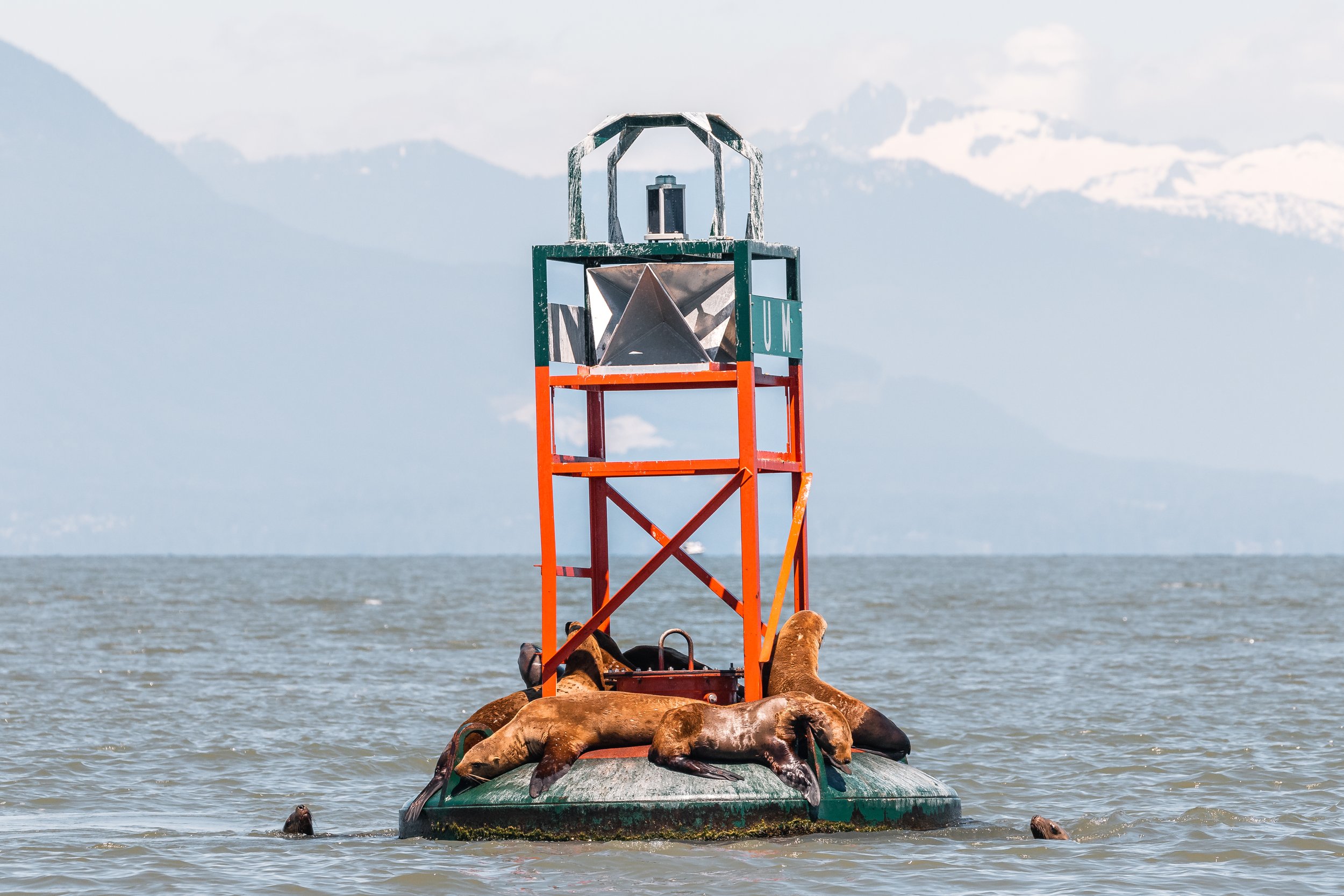July 12th - Zigzag in the Strait of Georgia
It was a lovely day on the water with one of our favorite girls, Zig Zag. Zig Zag is a known female who winters Hawaii and has returned to the Salish Sea every year since 2006. She’s brought back 2 calves with her, Scuba in 2019 and Schooner in 2021.
Zig Zag was busy earning her name today, as she zigged and zagged through the Strait of Georgia. Humpbacks are notorious for being tricky to follow as they often dive heading in one direction and surface somewhere else, heading in a different direction. Humpbacks, though slow, can cover lots of distance under water, especially if they are feeding on schooling fish. Once they find a good bait ball of food they often circle it or crisscross through it consuming as much as possible.
Zig Zag also has a tendency of being a lazy fluker, often slowly rolling her tail at the surface and making it difficult to ID her on the water. After some time she finally cooperated and showed off her tail for our naturalist as she dove with Mt. Baker in the background.
Photos by Marine Naturalists Cheyenne Brewster & Janine Van Der Linden.
Zig Zag (BCX1193). Photo by Janine Van Der Linden.
Zig Zag (BCX1193). Photo by Janine Van Der Linden.
Zig Zag (BCX1193). Photo by Cheyenne Brewster.
Zig Zag (BCX1193) also known as Trinity - can you see how she got these nicknames? Photo by Cheyenne Brewster.
Zig Zag (BCX1193). Photo by Cheyenne Brewster.
Zig Zag (BCX1193). Photo by Cheyenne Brewster.
Zig Zag (BCX1193). Photo by Cheyenne Brewster.
Zig Zag (BCX1193). Photo by Cheyenne Brewster.
Zig Zag (BCX1193). Photo by Cheyenne Brewster.
Zig Zag (BCX1193). Photo by Cheyenne Brewster.
Zig Zag (BCX1193). Photo by Cheyenne Brewster.
Zig Zag (BCX1193). Photo by Cheyenne Brewster.
Zig Zag (BCX1193). Photo by Cheyenne Brewster.
Zig Zag (BCX1193). Photo by Cheyenne Brewster.
Zig Zag (BCX1193). Photo by Cheyenne Brewster.
Zig Zag (BCX1193). Photo by Cheyenne Brewster.
Zig Zag (BCX1193). Photo by Cheyenne Brewster.
Zig Zag (BCX1193). Photo by Cheyenne Brewster.
Zig Zag (BCX1193). Photo by Cheyenne Brewster.
Zig Zag (BCX1193). Photo by Cheyenne Brewster.
Zig Zag (BCX1193). Photo by Cheyenne Brewster.
Photo by Janine Van Der Linden.
During the trip we spotted a large floating tree. We’ve had a lot of deadfall on the water lately, some from log booms and some clearly from the shores. Where does it all come from and why is there so much? A lot of this dead fall is actually a result of the extreme fire seasons we’ve experienced over the last few years. Wildfires have a lasting impact on the environment, often reaching areas far beyond the boundary of the fire itself. When a large tree burns up the roots also dye off and this creates very loose soil. Tree and plants roots are very important for holding soil together and keeping it in place during high rain and spring run off waters. Without trees and plants to hold the soil in place it’s ends up washing away, often causing landslides.
High winds are another things we face on the coast frequently, and after fires a lot of the dead trees have no roots to hold them in the ground. As soon as the next windstorm hits many of these trees topple and find their way into our rivers, lakes, and oceans.
These logs can become very hazardous, as they aren’t always as easy to see as this one. As longs absorb water they slowly sink and eventually become “dead-heads”. These are logs that are so water logged they sit almost vertically again, as if they are growing from the bottom of the ocean, and often only an inch or less is visible above the water. A captain who isn’t paying attention could easily miss those logs and they can do a lot of damage to a vessel when traveling at high speeds.
Our captains do an amazing job of spotting these hazards and avoiding them during the trips.
Sealions in the sunshine. Photo by Cheyenne Brewster.
Sealion side-eye. Photo by Cheyenne Brewster.
Go away, this is my spot! Photo by Cheyenne Brewster.
Our Semi Covered Vessel, Kula. Photo by Cheyenne Brewster.
Today we had a surprise visitor - a Blue Dasher (Pachydiplax longipennis) decided to check out our afternoon tour. Photo by Cheyenne Brewster.
Coming in for a landing! Photo by Cheyenne Brewster.
Almost there… Photo by Cheyenne Brewster.
Touchdown! Photo by Cheyenne Brewster.
Photo by Cheyenne Brewster.
This island usually homes many seals - today it was covered in gulls! Photo by Cheyenne Brewster.
Fully loaded and ready to go. Photo by Cheyenne Brewster.

































